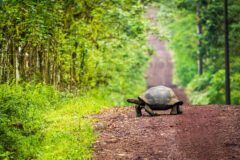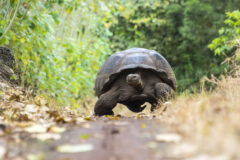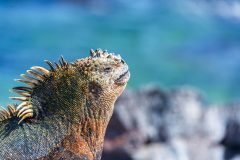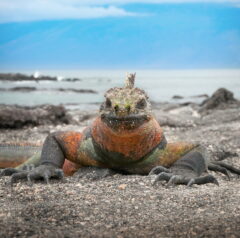Places to visit in Galapagos Islands

Baltra
Baltra is a small island which hosts the islands' principal airport and offers transport to Puerto Ayora by bus and ferry as well as private transfers for visitors.

Bartolome (Batholomew)
A walk to the summit of this small island reveals a pitted moonscape; one of the most photographed panoramas in the archipelago. There are views of the islands twisted lava formations and the sea-sculpted Pinnacle Rock, smothered with Galápagos penguins and marine turtles.

Espanola (Hood)
Remote and relatively flat, the island has a huge variety of birds and reptiles to see, nesting or just visiting its coves and cliffs. Some species such as the waved albatross are not found elsewhere. There’s a spectacular blowhole: spray shoots 30m high. A highlight for visitors is Urbina Bay with a long white beach hosting a sea-lion colony.

Fernandina (Narborough)
This is the most active volcanic island with eruptions every few years. Its steep flanks, streaked with successive lava flows, are mostly arid. Marine iguanas gather in their thousands at Punta Española. The only visitor site is at Punta Espinoza, a narrow ledge of lava and sand that extends from the base of the volcano to the sea and is teeming with wildlife. There’s a trail to walk along the shore and snorkelling is great here.

Floreana (Charles)
Floreana has an eventful human history involving pirates, whalers, convicts and colonists. You’ll almost certainly want to see Post Office Bay, where a barrel served as mailbox to send letters home, and snorkel around the Devil’s Crown, a part-submerged crater. There’s a golden beach, a nesting site for green turtles and a salt lagoon where you may spot and identify wading birds.

Genovesa (Tower)
This remote island is a low-lying volcano rising just above the ocean surface. It attracts a huge number of seabirds which rest up here and breed, including the red-footed booby. Darwin Bay was created when the island's large crater collapsed below sea level. Inside this caldera birds are visible in their thousands: you can hike along the rim. Snorkel with hammerhead sharks or take a boat ride along the rocky cliff ledges bringing you to the base of the steep rocky steps named after HRH Prince Philip.

Isabela (Albemarle)
The large, youthful island has five active volcanoes linked by twisted lava flows, bald of soil or vegetation. Its craggy cliffs and sandy speckled bays are ideal for exploration by boat and for coastal hikes. Puerto Villamil, its only village, has a tortoise breeding centre and a flamingo-filled lagoon. Tagus Cove is a natural harbour where pirates and whalers carved their ships’ names on the rocks, while the coral reef at Urbina Bay is a magnet for marine creatures. Punta Vicente Roca is the site of an ancient volcano and is one of the best marine sites to visit by boat or snorkelling.

North Seymour
North Seymour is a small island north of Baltra formed by uplifted lava. The whole island is covered with boulders and low bushy vegetation. You can watch the courting mating and nesting rituals here of frigate birds and blue-footed boobies, stroll on the beach or snorkel.

Plaza Islands
These are two tiny islands formed by lava streaming up from the sea-bed, home to a large number of species. They are famous for a cactus forest populated by land iguanas and for the extraordinary ground vegetation which changes its colour from intense green in the rainy season to orange and purple in the dry season. There’s a beautiful view from atop the steep banks and you can stroll along the base of the cliff. Hiking, birdwatching, swimming and snorkelling are all good here.

Rabida (Jervis)
This small but striking island has a dark bright-red coral sand beach and a saltwater flamingo lagoon. The landscape is studded with small volcanic craters along sharp slopes and cliffs. There’s a bird-flecked trail leading inland.

San Cristobal Island (Chatham)
An old island, it has eroded volcanic peaks in the north and rich vegetation in the south. The Interpretation Centre, an excellent place to learn about the natural and human history of the islands, is in Puerto Baquerizo Moreno, the capital of the Galápagos. There’s excellent snorkelling just off the beaches at Cerro Brujo. Isla Lobos is a dramatic basalt island outcrop which lives up to its name "sea lion island”.

Santa Cruz Island (Indefatigable)
The most highly populated island now has over 12,000 residents in the cattle farming communities of the forested highlands and the port Puerto Ayora, which is full of shops, bars and restaurants catering for visitors who board cruise vessels or stay in hotels here. The Charles Darwin Research Station and Galapágos National Park Information Centre are here and the main airport just a short boat ride away on Baltra Island. There are lava tunnels to explore and giant tortoises to spot roaming wild in the mountains.

Santa Fe (Barrington)
This is one of the most exquisite islands, with a lovely turquoise lagoon. Some of the giant cacti here grow up to 10m high. It is one of the oldest, with volcanic rocks about 4 million years old. The vegetation includes brush, palo santo trees and stands of prickly pear cactus. The visitor site is at Barrington Bay where a couple of trails lead inland but your walk might be frustrated by the presence of vast numbers of sea-lions on the beach.

Santiago Island (James)
The island, with two overlapping volcanoes, was a favourite for pirates and whalers. There are outstanding opportunities for wildlife viewing: bird-spotting is very rewarding here. Puerto Egas has Sally Lightfoot crabs to watch scampering along the shore-line and a trail across its harsh black hinterland. Stroll around the rock pools by the sea or climb Sugar Loaf volcano for views from its 395m summit. At Sullivan Bay there’s a ropy lava flow formed a mere 100 years ago.

Sombrero Chino (Chinese Hat)
The distinctive shape of this tiny volcanic cone island gave birth to its name. There’s a wet landing at the visitor site in a cove visited by sea-lions, from where there are good views of the cone; and a trail around the shore where you can walk among marine iguanas.
Papagaio
Your edit for Latin American inspiration
Our exciting range of articles on Latin America explore everything from iconic destinations and lesser-known cultural gems to delicious traditional recipes. You’ll also find exclusive travel tips, first-hand client reviews and the chance to get your personal questions answered by our travel experts.
View Extraordinary Inspiration







































